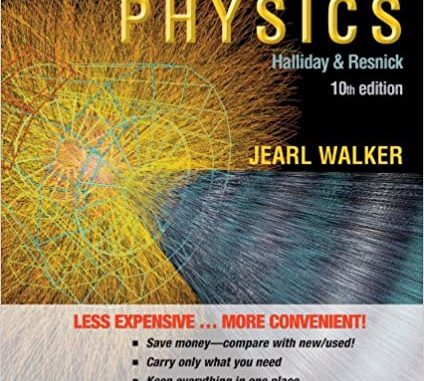
Fundamentals of Physics Extended by Halliday, Resnick and Walker is a college-level introductory textbook in Physics.
It covers the basics of mechanics and electromagnetism, which cover the typical two-course college introductory sequence in Physics. A few later chapters touch on relativity and nuclear physics, but the book stops short of a thorough introduction to modern physics (the material most colleges include as a third course).
Intended audience
According to the book’s preface, the intended audience is students who are preparing for careers in science and engineering. The book is typically used in introductory classes taken by college freshmen, with sophomores and upperclassmen less frequently taking these courses.
The book is not intended for (and would generally not be suitable for) more general-audience classes
Prerequisites
The text makes use of calculus, and I think would require a solid understanding of intro calculus in order to get the most of. A particularly ambitious or gifted student might be able to work through this book concurrently with taking calculus, but I would recommend for any student to have mastered the basics of calculus before using this book or taking a class centered around it.
No prior background in physics is assumed, but I think this book would be a bit tricky or advanced for a student who had truly never encountered the ideas in it before.
My experience with the book
I used this book in undergraduate, and kept it as a reference. I think it is well-written and gives a good amount of detail and explanation of the math in the conceptual exposition sections of each chapter. I especially like the way the book handles equations during the exposition–rather than just doing a bunch of mathematical manipulations, there is ample verbal explanation of what is going on, helping you to connect the equations to the concepts.
I think that this book is not quite as good at preparing people to do the problems and apply the concepts as it could be. The sample problems have explanations that look clear, but I find that there’s something missing in the philosophy or abstract approach to problem-solving that left me feeling deficient in setting up the problems. For me, this was no issue because I had access to competent professors and a community of peer students who addressed my problems. But I think this deficiency could make this book a little hard for someone trying to use it for self-study.
Edition creep
Like many popular, mainstream textbooks, this text suffers from what I call “edition creep”, a process through which more editions of the book are released, and the releases are more frequent, than would be optimal for corrections and improvements alone. Edition creep is driven by a profit motive in publishing.
This book is currently in the 10th edition, released in 2013. I think buying the latest edition is unnecessary. If you are willing to buy an old edition, such as the 5th, or even more recent ones, you can save a tremendous amount of money. Even going back just one edition, you can save a substantial amount.
Another way to save money is to buy a ringbound or loose-leaf copy rather than the usual hardback. These copies are still quite expensive, around $145 for the newest edition, contrasting with nearly $300 for the new book.
In summary
This is a solid textbook suitable for the first two introductory college level physics courses for engineers or science majors who have a background in calculus. It would not be suited for a more general audience of people lacking calculus background, and the level of depth is greater than necessary for students not intending to pursue a career in science. It also suffers from edition creep, and it would probably make sense to buy (or design a course around) older editions so as to save money.
Proudly WWW.PONIREVO.COM
Source by Alex Zorach



